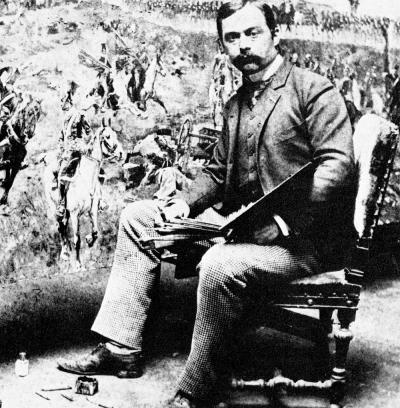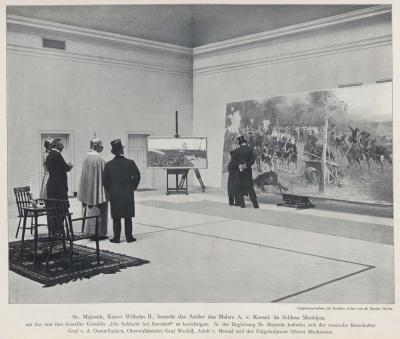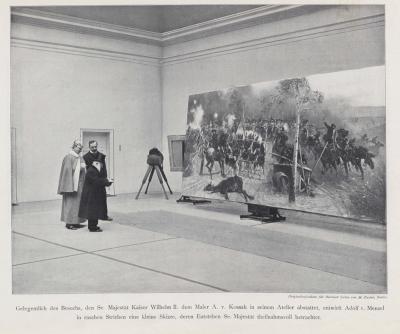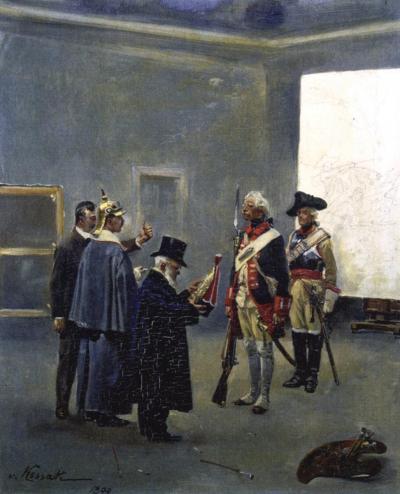Wojciech Kossak: The Battle of Zorndorf (1758), 1899
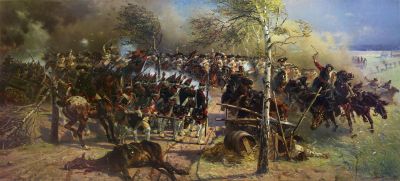
Wojciech Kossak was born in Paris in 1856 where his parents lived for several years. His father Juliusz Kossak (1824-1899) was also a painter whose favourite themes were horses, battles and historical portraits. In 1869 the family moved to Kraków. In summer 1871 he began to study painting at the Kraków School of Art (Szkoła Rysunku i Malarstwa) under Władysław Łuszczkiewicz. And from 1874 to 1866 he continued his studies at the Academy of Pictorial Arts in Munich. Here, since the 1860s, there had grown up a veritable “colony of Poles” around the Polish painter Józef Brandt. In 1877 he travelled to Paris, where one of his teachers at the École des Beaux-Arts was Léon Bonnat. In 1884 he returned to Kraków, found a wife and painted in his own workshop for the following ten years. In 1893 he collaborated with the Lemberg painter Jan Styka on the “Panorama of the Battle of Racławice”, and one year later this was shown in Lemberg/Lwów (it can now be seen in Breslau/Wrocław). The cycloramic painting shows the victory of the Polish peasant army (they were only armed with scythes) under the leadership of Tadeusz Kościuszko, over the troops of the Czar on 4 June 1794 in the region of Kielce.
In 1895 Kossak accepted an invitation from his colleague Julian Fałat – like Kossak he had also studied painting in Kraków and Munich – to come to Berlin. Since 1889 Fałat had been active as a painter at the court of Wilhelm II, and for a long time he had been planning a broad panorama to depict “The Crossing of the Beresina by Napoleon’s troops”. And because Kossak had made a name for himself with his Panorama of Racławice – since its first showing visitors had been streaming to see it as a symbol of Polish nationalism – he seemed to be the right person for this task. Working with other Polish and German painters, Fałat and Kossak managed to complete the Beresina Panorama within the space of sixteen months. The painting, which was 17 metres high and 115 metres in length, was first shown to the general public on 1 April 1896 in Berlin. The Kaiser made Kossak’s acquaintance during a visit to view the panorama. In the following years Kossak specialised in horses and battle scenes which he painted for members of the Berlin upper classes and Prussian aristocrats in his workshop in Charlottenburg. In spring 1897 he managed to attract the attention of the Kaiser once again. Wilhelm invited him to some autumn manoeuvres and put a workshop at his disposal in Monbijou Palace not far from the City Palace. It had served as the Hohenzollern Museum since 1877.
Over the following five years Kossak painted two portraits of the Kaiser on horseback, along with six battle scenes from the Seven Years War and the wars of liberation conducted by Prussia and Russia against Napoleonic rule in Europe. Kossak became increasingly friendly with the Kaiser and his wife and this led to Wilhelm receiving private invitations to the City Palace and spontaneous visits to his workshop, where he eulogised about Kossak’s battle scenes. Kossak spoke of “gracious recognition”, generous patronage and prompt payments. In Berlin he operated under the name of Adalbert Ritter von Kossak, an Austrian/Galician noble’s title.
The first picture he painted for Wilhelm was “The Royal Grenadiers near Etoges 1814”, upon which the Kaiser commissioned him in March 1898 to paint a picture portraying the glorious history of the regiment, intended to be hung in the regiment mess of the Gardes du Corps in Potsdam. The theme was the cavalry attack led by the young General Friedrich Wilhelm von Seydlitz in the Battle of Zorndorf on the 25. August 1758 during the Seven Years War. Here William succeeded in stopping the oncoming Russian army from moving into the County of Brandenburg. Kossak worked on the painting, now known as the “Battle of Zorndorf”, from September 1898 until the following April. Immediately after it was completed, the monumental portrait (it measured 2.7 x 6 metres), was displayed from May to September 1899 at the Greater Berlin Art Exhibition at the Lehrter Bahnhof. After that it was officially placed in the regiment mess in Potsdam in October 1899.
The general public learnt all about the painting not only through the exhibition in Berlin. The popular illustrated magazine “Berliner Leben. Zeitschrift für Schönheit und Kunst”, also reported on the preceding visit by the Kaiser to Kossak’s workshop to view the newly completed picture, accompanied by the painter Adolf v. Menzel and the Russian ambassador. The magazine also published two photographs commissioned by Cossack in anticipation of the visit, and reported: “His Majesty is reputed to be an extremely ardent visitor to the artist’s workshop and honours him with commissions. Indeed the Kaiser follows the creation of the art works he has ordered with passionate interest because the ideas for the great majority of them spring from his own mind. For this reason the monarch has recently conducted a number of regular conversations with the Polish painter A. v. Kossak to whom he has allotted a special workshop in the Monbijou Palace in which to paint his large-scale battle scenes. […] The two portraits of the Kaiser in the current edition of this magazine are original photos taken, with the consent of his Majesty, in the workshop of Herr v. Kossak. Adolf v. Menzel was also present at the express wish of the Kaiser […] In this case the Kaiser placed great value on Menzel’s presence because the subject of the painting was from the time of Frederick the Great, on whom Adolf v. Menzel is the major expert”.
In his painting Kossak portrayed the events from the perspective of the rank-and-file soldiers, as was usual in battle scenes since the Napoleonic age. By doing so he shifts the attention of the observer to the centre of the drama. In the middle of the picture is a row of Russian Grenadiers with their backs to us (recognisable by their tall red caps with a white edging and bobble) towards whom the Prussian cavalry (in black three cornered hats and raised sabres) from the Gardes-du-Corps is riding. To the left can be seen a Russian banner. In the background on the left edge of the picture Zorndorf can be seen in flames. Now known under the name of Sarbinowo it is located a few kilometres north-east of Küstrin/Kostrzyn nad Odrą. In the foreground the drama is emphasised by a dying horse and a dead soldier next to a munitions cart that has smashed into a birch tree. A further scene is grouped around the tall trunk of the leafy tree. This shows a Kalmyk on horseback aiming a bow and arrow at an oncoming Prussian officer in pursuit of a wagon drawn by three horses on the right edge of the painting. Frederick the Great is approaching with his troops from the distance.
Kossak did a lot of careful research before starting on the picture. In his letters to his wife he wrote that he had not only studied historical documents in the secret archive of the Ministry of War but had also travelled with officers of the regiment to the former battlefield. “We walked up and down the field for the whole day in terrible heat to consider the composition down to the last detail.” He also had some authentic uniforms and weapons delivered to his workshop from the Military Museum in the Berlin Armoury; and these he used as models. Smaller oil paintings in which he describes this procedure, show him with Wilhelm II and Menzel studying the uniformed soldiers and parts of their uniforms in front of preliminary sketches of the battle on a white canvas. These are probably imaginary scenes for they resemble the photographs of the Kaiser’s visit that were only taken after the completion of the picture. The composition and perspective is astounding.
The artist was more than satisfied with the success of his picture. Whilst he was working on “The Battle of Zorndorf” the Kaiser commissioned him to paint a picture of himself on horseback. Kossak worked on this simultaneously in the Monbijou Worksop during which the Kaiser indicated that he would be commissioning more works from him. It was not only the historical details but also the dramatic rendering of the events with their inherent glorification of the Gardes-du-Corps, that gave Kossak the impression that his intentions for the picture had resulted in “something tremendously original”.
The Prussian Higher Regional Equerry, Georg Graf von Lehndorff, who had been the head of the regiment in recent years also visited the workshop, and subsequently Kossak wrote to his wife: “There entered a cold, stiff, old man who must have been at least ninety years old who, when he left, was full of enthusiasm, vibrant energy and congratulations. He said to me, this stiff Teutonic Knight, that he had never seen such a picture in which there was so much energy and life.” Władysław Stodolnicki, the author of the Polish weekly “Kraj“ that was published in St Petersburg (he was originally born in Lublin), also visited Kossak in his workshop on various occasions and wrote positively about the work of the Polish painter.
The favourable attitude of the Polish press, however, soon turned into open criticism. Given the fact that German policies were becoming increasingly hostile to Poland since the new Reich Chancellor Bernhard von Bülow had taken office in 1900, Kossak’s intimacy with the Kaiser’s family was increasingly regarded as being inappropriate. He no longer felt comfortable in Berlin, the more so because he also sensed anti-Polish attitudes amongst the intellectuals. As a result he began to concern himself more and more with national Polish themes. After Wilhelm II delivered a pithy speech against the Polish national movement at Marienburg Castle to Prussian members of the Order of St John dressed in the uniforms of Teutonic Knights in spring 1902 – “Now it has come to this once more! Polish arrogance is becoming offensive to the Germanic spirit.” – Kossak returned to Kraków. In the following years he dedicated his energies to themes critical of Prussia, such as the cycle of paintings entitled “Prussian spirit” (1909), including the well-known oil painting “The Expulsion of Poles from Prussia”. In his “Memoirs”, published in 1913, he tried to play down his closeness to the Hohenzollerns and his elevation of Prussia in the paintings he had made during his time in Berlin. Nonetheless the stain of being a Prussian court painter remained with him in Poland to the end of his life. Despite this he still enjoys huge popularity in Poland today as the painter of national historical themes and key portraits.
In 1923 “The Battle of Zorndorf” was taken from the regiment mess in the Potsdam garrison Museum and placed in the former Royal Stables near the Lustgarten. When this building was destroyed and plundered in 1945 it was rolled up and placed in a storeroom. Here it was discovered in a heavily damaged state in 1966 by staff from the Potsdam Museum. But it was not until 1996 that it was once more presented to the general public in exhibitions. In 2004 the energy concern E.ON edis AG , whose headquarters were in the renovated building that once housed the regiment mess, commissioned the painting to be restored. It now hangs here as a loan from the Potsdam Museum.
Axel Feuß, September 2015
Further reading:
Skowrońska: Kossask, Wojciech, in: Österreichisches Biographisches Lexikon 1815-1950, Volume 4, 17. Lieferung, 1967, p. 150
Stefan Dyroff: Wojciech Kossak. Panorama- und Schlachtenmaler für Deutsche und Polen. Deutsch-polnische Denkwürdigkeiten in seinem Werk, seinem Umfeld und seiner Rezeption, in: Wanderungen: Künstler, Kunstwerk, Motiv, Stifter, edited by Małgorzata Omilanowska, Warsaw 2005, pp. 79-101
Frank Bauer: Die Schlacht bei Zorndorf. 25. August 1758, Potsdam 2005
Anna Baumgartner: Fałat und Kossak. Polnische Maler im preußischen Berlin Ende des 19. Jahrhunderts, in: My, berlińczycy! Wir Berliner! Geschichte einer deutschpolnischen Nachbarschaft, edited by Robert Traba, Leipzig 2009, pp. 140-158
Anna Baumgartner : Ein polnischer Nationalmaler am preußischen Hof. Wojciech Kossak und sein wiederentdecktes Gemälde Schlacht bei Zorndorf (1899), in: zeitenblicke 10, Nr. 2, 2011, auf: zeitenblicke.de/2011/2/Baumgartner/index_html
Stefan Troebst: Karrierekatalysator Pferd. Der Krakauer Schlachten- und Historienmaler Wojciech Kossak (1857–1942) als Staatskünstler des Deutschen Kaiserreiches und der Zweiten Polnischen Republik, auf: Themenportal Europäische Geschichte (2013), europa.clio-online.de/2013/Article=570
I. Kopania: Kossak, Juliusz, in: Allgemeines Künstlerlexikon (AKL), vol. 81, 2013
J. Różalska: Kossak, Wojciech, in: Allgemeines Künstlerlexikon (AKL), vol. 81, 2013
